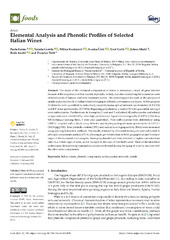Приказ основних података о документу
Elemental Analysis and Phenolic Profiles of Selected Italian Wines
| dc.creator | Fermo, Paola | |
| dc.creator | Comite, Valeria | |
| dc.creator | Sredojević, Milica | |
| dc.creator | Ćirić, Ivanka | |
| dc.creator | Gašić, Uroš | |
| dc.creator | Mutić, Jelena | |
| dc.creator | Baošić, Rada | |
| dc.creator | Tešić, Živoslav | |
| dc.date.accessioned | 2021-03-12T10:54:52Z | |
| dc.date.available | 2021-03-12T10:54:52Z | |
| dc.date.issued | 2021 | |
| dc.identifier.issn | 2304-8158 | |
| dc.identifier.uri | internal-pdf://Fermo et al. - 2021 - Elemental Analysis and Phenolic Profiles of Selected Italian Wines.pdf | |
| dc.identifier.uri | https://www.mdpi.com/2304-8158/10/1/158 | |
| dc.identifier.uri | https://radar.ibiss.bg.ac.rs/handle/123456789/4160 | |
| dc.description.abstract | The study of the chemical composition of wines is nowadays a topic of great interest because of the importance of this market, especially in Italy, and also considering the numerous cases of falsification of famous and very expensive wines. The present paper focused on the analysis of metals and polyphenols in Italian wines belonging to different provenance and types. At this purpose 20 elements were quantified by inductively coupled plasma optical emission spectrometry (ICP-OES) and ICP mass spectrometry (ICP-MS). Regarding polyphenols, a total of 32 were quantified, among 6 were anthocyanins. Furthermore, in 4 samples (1 rosè and 3 red wines) 42 anthocyanins and related compounds were identified by ultra-high performance liquid chromatography (UHPLC)-Orbitrap MS technique (among these, 6 were also quantified). Non-anthocyanins were determined using UHPLC coupled with a diode array detector and triple-quadrupole mass spectrometer (UHPLC–DAD-QqQ-MS). Total phenolic content (TPC) and radical scavenging activity (RSA) were measured using spectrophotometric methods. The results obtained by elemental techniques were submitted to principal components analysis (PCA) allowing to get information on both geographical and botanical origin of the examined wine samples. Some polyphenols have been detected in higher concentrations only in a certain type of wine, as for example in the case of Grechetto wine. Most of the identified anthocyanin derivatives (pyranoanthocyanins) are formed during the aging of wine by reaction with the other wine components. | |
| dc.publisher | MDPI AG | |
| dc.relation | info:eu-repo/grantAgreement/MESTD/inst-2020/200007/RS// | |
| dc.relation | info:eu-repo/grantAgreement/MESTD/inst-2020/200288/RS// | |
| dc.relation | info:eu-repo/grantAgreement/MESTD/inst-2020/200168/RS// | |
| dc.rights | openAccess | |
| dc.rights.uri | https://creativecommons.org/licenses/by/4.0/ | |
| dc.source | Foods | |
| dc.subject | Italian wines | |
| dc.subject | Anthocyanins | |
| dc.subject | Metals | |
| dc.subject | Minerals | |
| dc.subject | Phenolic compounds | |
| dc.title | Elemental Analysis and Phenolic Profiles of Selected Italian Wines | |
| dc.type | article | en |
| dc.rights.license | BY | |
| dcterms.abstract | Цомите, Валериа; Тешић, Живослав; Баошић, Рада; Фермо, Паола; Средојевић, Милица; Ћирић, Иванка; Гашић, Урош; Мутић, Јелена; | |
| dc.rights.holder | © 2021 by the authors. Licensee MDPI, Basel, Switzerland. | |
| dc.citation.issue | 1 | |
| dc.citation.volume | 10 | |
| dc.identifier.doi | 10.3390/foods10010158 | |
| dc.identifier.pmid | 33451091 | |
| dc.identifier.scopus | 2-s2.0-85101618437 | |
| dc.identifier.wos | 000610220500001 | |
| dc.citation.apa | Fermo, P., Comite, V., Sredojević, M., Ćirić, I., Gašić, U., Mutić, J., et al. (2021). Elemental Analysis and Phenolic Profiles of Selected Italian Wines. Foods, 10(1), 158. | |
| dc.citation.vancouver | Fermo P, Comite V, Sredojević M, Ćirić I, Gašić U, Mutić J, Baošić R, Tešić Ž. Elemental Analysis and Phenolic Profiles of Selected Italian Wines. Foods. 2021;10(1):158. | |
| dc.citation.spage | 158 | |
| dc.type.version | publishedVersion | |
| dc.identifier.fulltext | https://radar.ibiss.bg.ac.rs/bitstream/id/8263/foods-10-00158-v2.pdf | |
| dc.citation.rank | M21 |

